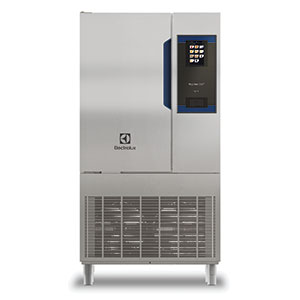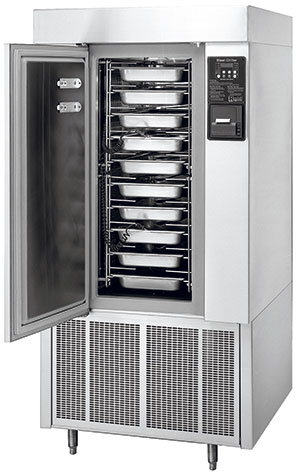Essentially souped-up freezers, blast chillers are most often used by large institutions like hospitals, which need to produce and store food in high volume. They’re also high-dollar pieces of equipment that need to be well-maintained to work at peak efficiency.
Maintaining blast chillers is important from a safety standpoint since temperature consistency is key for HACCP reporting.
The menu will help determine if a foodservice operation requires a blast chiller and, if so, the appropriate size. More delicate food like bakery items may be better suited for a softer, more gradual chill process, while meat and other heartier products can withstand a hard chill that brings food temperatures down to an almost frozen state more quickly.
Blast chillers bring down food temperatures from 160 degrees F to 38 degrees F in 90 minutes or less to reduce the time food is in the danger zone of between 41 degrees F and 135 degrees F. Because this chilling method forms microcrystals on products, food retains its quality, appearance, nutritional value and flavor.
Blast chillers are a key piece of equipment for industrial operations that want to cook, then store, large quantities of food. They’re also big-ticket items that operators should be careful with to protect their investments.
With blast chillers, proper temperatures can mean the difference between maintaining food quality during cooling and potentially creating an unsafe environment that breeds bacteria. Proper blast chiller maintenance is important from a safety standpoint since temperature consistency is key for HACCP reporting.
Featured Products
-

SkyLine Chill Blast Chiller-Freezer 102
Electrolux Professional
This blast chiller can take 220 pounds of food from 195 degrees F to 37 degrees F in less than 90 minutes, according to the maker. Features include a high-resolution, touch-screen interface that translates into more than 30 languages; a cooling fan that operates at 7 different speeds and timer that can manage up to 20 different cooking cycles. The fan stops within five seconds of the door opening.
-

Randell BC Series Blast Chillers
Unified Brands
Randell BC Series Blast Chillers have touch-screen controls and an auto-launch cooling feature. A color-coded probe identification system ensures proper probe placement. Reach-in, work-top and undercounter models are available. The three models come standard with a front-mounted USB port for retrieving recorded data for HACCP program documentation.
Related Articles
-
What to Consider When Specifying Reach-Ins
Read FeatureThe confluence of high labor costs and consumers’ need for speed creates a recipe for accessible, portable food options, either as the main meal or as add-on items. As a result, the role of the reach-in continues to evolve from simple storage item to profit center for many foodservice operators, including fast-casual and quick-service operators.
-
What to Consider When Purchasing Undercounter Refrigeration
Read FeatureUndercounter and underbar refrigeration serve as supplemental storage solutions for the front of house or in the kitchen as part of a prep station. Timothy A. Barker, founder of Table & Bar Consulting Group in Memphis, Tenn., provides information on what to consider when purchasing undercounter refrigeration.











